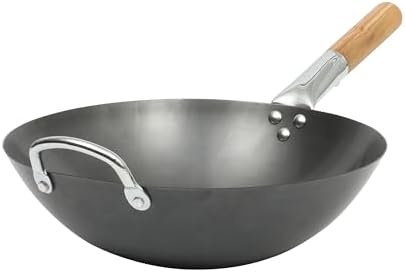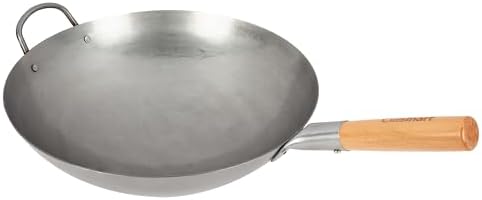Understanding Carbon Steel Woks
Carbon steel woks are typically favored by chefs. They have special qualities and versatility in various cooking methods. They have iron and a trace of carbon. They have great heat retention and distribution. This is an important feature in cooking. It allows the temperature to remain even. This guarantees food cooks efficiently and evenly. Carbon steel’s high heat conductivity makes it possible for chefs to heat them up to a high temperature. They are required for those old-fashioned stir-fries, searing, and browning. This makes them staples in most kitchens.
A characteristic of carbon steel woks is their ability to form a natural non-stick surface. This is achieved by proper seasoning. Differing from non-stick pans, however, carbon steel establishes its non-stick surface. It develops a patina over time. It also enhances the ability of the wok to cook. It also contributes to enhancing the flavors of the dishes. Stir-frying vegetables and meat with a well-seasoned carbon steel wok will add a unique depth of flavor. This significantly enhances the food experience.
Carbon steel woks are also quite versatile. Chefs can utilize them to carry out a variety of cooking techniques. Some of these include stir-frying, steaming, braising, and deep-frying. This makes them an excellent addition to the kitchen. They also weigh less than cast-iron woks. This is advantageous for handling ease while cooking. This versatility, with lifetime use if well maintained, makes understanding how to care for a carbon steel wok necessary. Understanding the nature of the carbon steel will eventually lead to improved cooking outcomes. It will also give the cookware a longer lifespan.
Proper Seasoning Techniques
Proper seasoning is essential. It maintains a carbon steel wok in good working and condition. Seasoning avoids rust formation on the surface. It also makes the wok non-stick more. This makes it essential to any cook seeking the best outcome. To start with, use a fresh carbon steel wok. The first thing to do is clean the wok thoroughly. This strips away oils or factory finishes. One good method is to wash it in hot water and a mild detergent. Scrub with a scrub pad. Wash the wok after cleaning. Dry the wok with a cloth or on the stove.
Next, oil the surface of the wok in a thin coat. Vegetable oil, flaxseed oil, and grapeseed oil are three common choices. These all have good high smoke points. Pour a small amount of oil into the wok. Use a paper towel to spread it evenly across the interior. Ensure every area is coated. After applying the oil, heat the wok on medium-high. Heat until the oil begins to smoke. This process polymerizes the oil. It forms a protective layer. This imparts a natural non-stick surface. Allow the wok to cool. Subsequently, use a dry cloth to wipe away any excess oil.
Once seasoned for the first time, periodic re-seasoning is essential. Do so particularly after frequent use or washing. Re-seasoning keeps rust from forming. If you see any dull patches or rust, re-do the cleaning and oiling. Periodic cooking of oily foods is recommended. This keeps the seasoned surface in good condition. A carbon steel wok well-seasoned can last decades. This easy but effective method is a must for any foodie.
Cleaning and Maintenance Best Practices
It is essential to maintain your carbon steel wok correctly. It prolongs its life as well as ensures that it functions best while cooking. Clean as per practices with caution. This ensures the maintenance of the natural non-stick surface that is formed due to seasoning. One simple rule is not to use soap or dishwashers. These kill the protective layer formed by seasoning. Clean using hot water and a gentle sponge or cloth instead. For stubborn food residue, a soft spatula or wooden spoon will be easily removed. This avoids damaging.
Drying the wok thoroughly after cleaning is imperative. The easiest way is to heat the wok on the stovetop by using low heat. Heat until all water is evaporated. This practice keeps the wok dry from head to toe. It also resurfaces the seasoning layer by keeping the oils intact. These safeguard it against rust. Since water is the key factor in rusting, proper storage is unavoidable. Dry store the wok. In case stacking is unavoidable, a paper towel or cloth will have to be sandwiched between woks. This prevents scratching and moisture holdup.
Aside from these cleaning guidelines, upkeep will also maintain your carbon steel wok in perfect condition. Following cleaning, a small layer of cooking oil stops drying out of the seasoning. It also prevents rust. Additionally, reseason the wok every now and then. This rejuvenates the protective coating. Do this especially when food sticks or the seasoning appears worn out. Your carbon steel wok can provide excellent cooking performance for decades with these tips.
Methods of Cooking to Maintain Your Wok
Proper cooking procedures are also essential. This prolongs the lifespan of your carbon steel wok. One of these is using the correct cooking utensils. Silicone or wooden utensils are ideal. These will not easily scratch the wok surface. Metal utensils provide premature wear and tear. By utilizing these gentler utensils, you preserve the integrity of the seasoning on the wok. This is particularly significant for its non-stick quality and overall performance.
Also, notice temperature. The material conducts and holds heat quite well. Too high a temperature will damage the wok and your food. A moderate fire will do. This helps to maintain the wok and enhance the flavor. It provides a more even cooking temperature.
Another approach to consider is avoiding highly acidic foods. Tomatoes and citrus foods are a couple of examples. Acid can destroy the seasoning layer. Rust and unfavorable impacts on flavor result from this. Instead, focus on a great variety of vegetables, proteins, and starches. These complement the seasoning and create a more satisfying overall cooking experience.
And besides, watch out for high-heat cooking methods. Stir-frying does produce the characteristic flavor that wok cooking has. Nevertheless, keep the heat under close control. That way, you maintain the cooking surface properly shielded. Using these strategies together, you effectively minimize damage to your wok. It will remain in top shape for years of cooking adventures.













[…] If you’ve ever stared at a pile of dirty dishes and thought, “There’s got to be a better way to clean these without harming the planet,” you’re not alone. A lot of us are rethinking the products we use daily starting with what goes into our dishwashers. […]
[…] starts with preheating the carbon steel wok to the appropriate temperature. Place the wok on high heat. Allow it to heat to its optimum […]